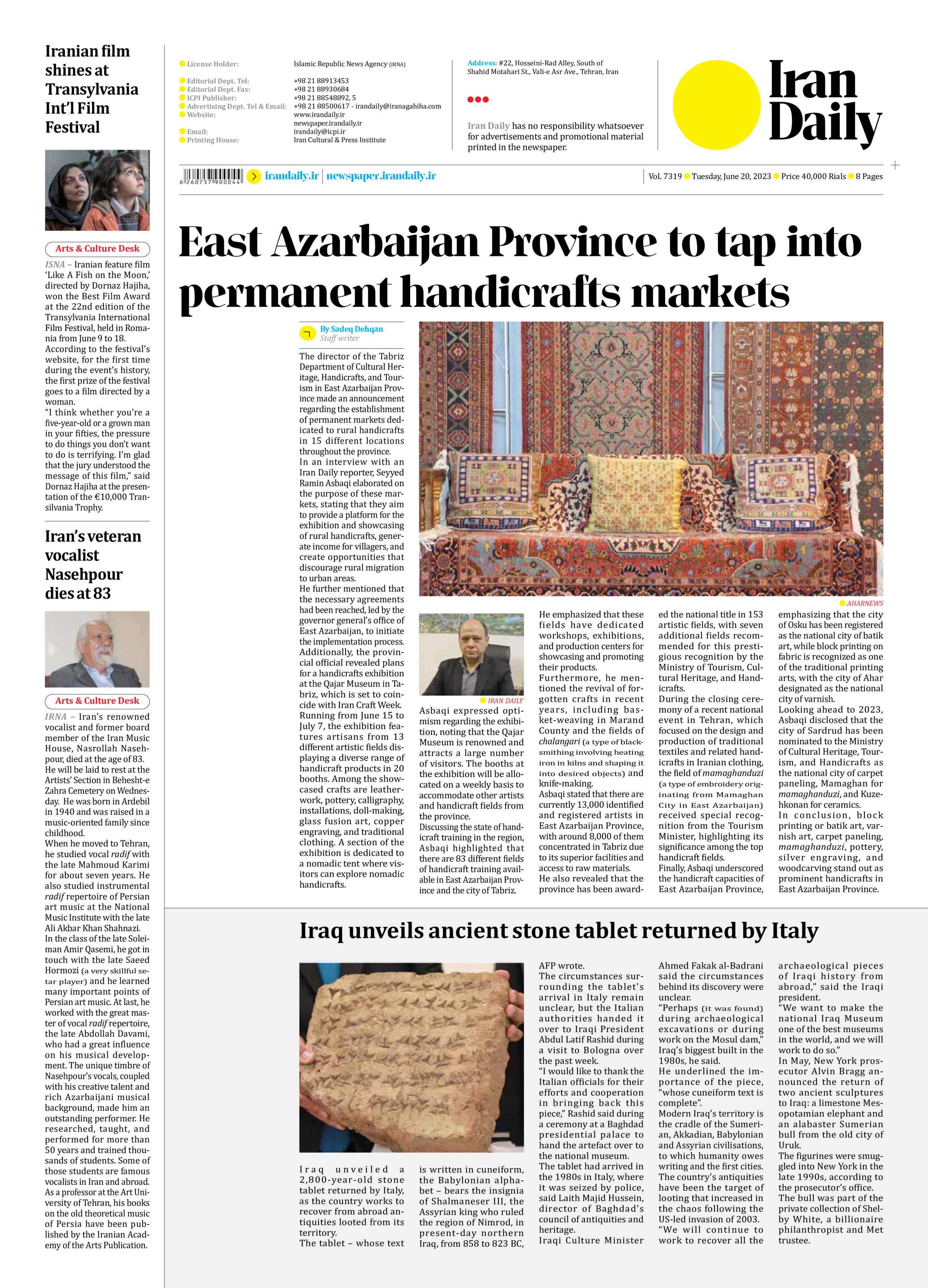
East Azarbaijan Province to tap into permanent handicrafts markets
By Sadeq Dehqan
Staff writer
The director of the Tabriz Department of Cultural Heritage, Handicrafts, and Tourism in East Azarbaijan Province made an announcement regarding the establishment of permanent markets dedicated to rural handicrafts in 15 different locations throughout the province.
In an interview with an Iran Daily reporter, Seyyed Ramin Asbaqi elaborated on the purpose of these markets, stating that they aim to provide a platform for the exhibition and showcasing of rural handicrafts, generate income for villagers, and create opportunities that discourage rural migration to urban areas.
He further mentioned that the necessary agreements had been reached, led by the governor general’s office of East Azarbaijan, to initiate the implementation process.
Additionally, the provincial official revealed plans for a handicrafts exhibition at the Qajar Museum in Tabriz, which is set to coincide with Iran Craft Week.
Running from June 15 to July 7, the exhibition features artisans from 13 different artistic fields displaying a diverse range of handicraft products in 20 booths. Among the showcased crafts are leatherwork, pottery, calligraphy, installations, doll-making, glass fusion art, copper engraving, and traditional clothing. A section of the exhibition is dedicated to a nomadic tent where visitors can explore nomadic handicrafts.
Asbaqi expressed optimism regarding the exhibition, noting that the Qajar Museum is renowned and attracts a large number of visitors. The booths at the exhibition will be allocated on a weekly basis to accommodate other artists and handicraft fields from the province.
Discussing the state of handicraft training in the region, Asbaqi highlighted that there are 83 different fields of handicraft training available in East Azarbaijan Province and the city of Tabriz.
He emphasized that these fields have dedicated workshops, exhibitions, and production centers for showcasing and promoting their products.
Furthermore, he mentioned the revival of forgotten crafts in recent years, including basket-weaving in Marand County and the fields of chalangari (a type of blacksmithing involving heating iron in kilns and shaping it into desired objects) and knife-making.
Asbaqi stated that there are currently 13,000 identified and registered artists in East Azarbaijan Province, with around 8,000 of them concentrated in Tabriz due to its superior facilities and access to raw materials.
He also revealed that the province has been awarded the national title in 153 artistic fields, with seven additional fields recommended for this prestigious recognition by the Ministry of Tourism, Cultural Heritage, and Handicrafts.
During the closing ceremony of a recent national event in Tehran, which focused on the design and production of traditional textiles and related handicrafts in Iranian clothing, the field of mamaghanduzi (a type of embroidery originating from Mamaghan City in East Azarbaijan) received special recognition from the Tourism Minister, highlighting its significance among the top handicraft fields.
Finally, Asbaqi underscored the handicraft capacities of East Azarbaijan Province, emphasizing that the city of Osku has been registered as the national city of batik art, while block printing on fabric is recognized as one of the traditional printing arts, with the city of Ahar designated as the national city of varnish.
Looking ahead to 2023, Asbaqi disclosed that the city of Sardrud has been nominated to the Ministry of Cultural Heritage, Tourism, and Handicrafts as the national city of carpet paneling, Mamaghan for mamaghanduzi, and Kuzehkonan for ceramics.
In conclusion, block printing or batik art, varnish art, carpet paneling, mamaghanduzi, pottery, silver engraving, and woodcarving stand out as prominent handicrafts in East Azarbaijan Province.







